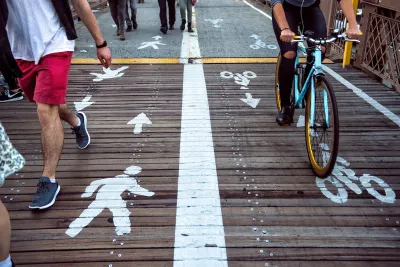A comprehensive new website provides information on why and how to improve community walkability and offers practical tools for evaluating walking conditions.

Walkability is a crucial first step in creating sustainable transportation in an urban environment.
Effectively understanding and measuring the complex ecology of walkability has proven challenging for many organizations and governments, given the various levels of policy-making and implementation involved. In the past, Western and Eurocentric standards have permeated measurement attempts and have included data collection practices that are too complicated to have utility in many parts of the world or at a level beyond that of the neighborhood.
To expand the measurement of walkability to more places and to promote a better understanding of walkability, the Institute for Transportation and Development Policy (ITDP) has developed the Pedestrians First online toolkit. This tool will facilitate the understanding and measurement of the features that promote walkability in urban environments around the world at multiple levels. With a better global understanding of walkability, and more consistent and frequent measurement of the walkability of urban environments, decision-makers will be empowered to enact policies that create more walkable urban areas.
FULL STORY: Pedestrians First: Tools for a Walkable City

National Parks Layoffs Will Cause Communities to Lose Billions
Thousands of essential park workers were laid off this week, just before the busy spring break season.

Retro-silient?: America’s First “Eco-burb,” The Woodlands Turns 50
A master-planned community north of Houston offers lessons on green infrastructure and resilient design, but falls short of its founder’s lofty affordability and walkability goals.

Delivering for America Plan Will Downgrade Mail Service in at Least 49.5 Percent of Zip Codes
Republican and Democrat lawmakers criticize the plan for its disproportionate negative impact on rural communities.

Test News Post 1
This is a summary

Test News Headline 46
Test for the image on the front page.

Balancing Bombs and Butterflies: How the National Guard Protects a Rare Species
The National Guard at Fort Indiantown Gap uses GIS technology and land management strategies to balance military training with conservation efforts, ensuring the survival of the rare eastern regal fritillary butterfly.
Urban Design for Planners 1: Software Tools
This six-course series explores essential urban design concepts using open source software and equips planners with the tools they need to participate fully in the urban design process.
Planning for Universal Design
Learn the tools for implementing Universal Design in planning regulations.
EMC Planning Group, Inc.
Planetizen
Planetizen
Mpact (formerly Rail~Volution)
Great Falls Development Authority, Inc.
HUDs Office of Policy Development and Research
NYU Wagner Graduate School of Public Service





























